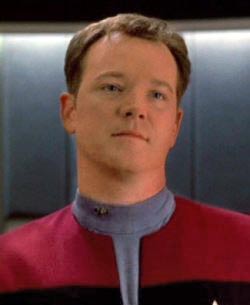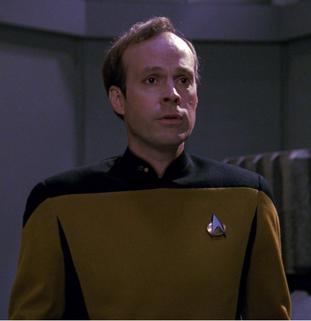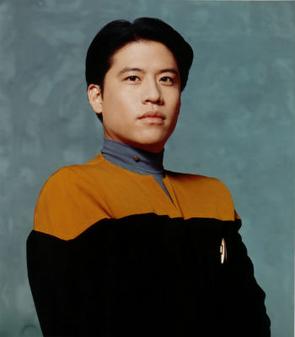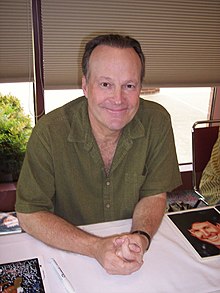
The Doctor, an Emergency Medical Hologram, is a fictional character portrayed by actor Robert Picardo on the television series Star Trek: Voyager, which aired on UPN between 1995 and 2001. He is an artificial intelligence manifesting as a holographic projection, designed to act as a short-term supplement to the medical staff of a starship during emergency situations. However, when the starship Voyager is stranded on the far side of the galaxy with no surviving medical personnel, he is forced to act as the ship's chief medical officer for several years. In an example of the Star Trek franchise's exploration of artificial intelligence, a simple software program becomes a major character in the show.

Kes is a fictional character on the American science fiction television show Star Trek: Voyager. She is portrayed by actress Jennifer Lien. Set in the 24th century of the Star Trek universe, the series follows the crew of the starship USS Voyager, stranded far from home and struggling to get back to Earth. Kes is a member of the Ocampa who joins the crew in the series' premiere episode along with her Talaxian boyfriend, Neelix. She subsequently works as the Doctor's medical assistant and develops her mental abilities with Tuvok's assistance.

Lieutenant Thomas Eugene "Tom" Paris is a fictional character in the American science fiction television series Star Trek: Voyager and is portrayed by Robert Duncan McNeill. Paris is the chief helmsman, as well as a temporary auxiliary medic, of the USS Voyager, a Starfleet ship that was stranded in the Delta Quadrant by an alien entity known as the Caretaker.

Reginald Endicott Barclay III is a fictional engineer from the Star Trek media franchise. On television and in film, he has been portrayed by Dwight Schultz since the character's introduction in the Star Trek: The Next Generation third season episode "Hollow Pursuits." Schultz played the character for five episodes and one feature film of The Next Generation, as well as six episodes of the series Star Trek: Voyager. Barclay also appears in non-canon Star Trek novels and video games.

The Kazon are a fictional alien race in the Star Trek franchise. Developed by Star Trek: Voyager series' co-creators Rick Berman, Michael Piller, and Jeri Taylor, the Kazon serve as the primary antagonists during the show's first two seasons. They are represented as a nomadic species divided into eighteen separate sects, and characterized by their reliance on violence. A patriarchal society, the Kazon have a low opinion of women, and place pride in men becoming warriors and proving themselves in battle. The Kazon storylines frequently revolve around the attempts of Jal Culluh and his Kazon sect to steal technology from the USS Voyager, with the assistance of former Voyager ensign Seska. During the second season, the Voyager crew uncover more about the alien species' history and culture through a temporary truce. In their final major appearance, the Kazon successfully commandeer Voyager, but are eventually forced to surrender and retreat. The alien species have minor cameo appearances and references in the show's subsequent seasons, and have also been included in Star Trek Online and novels set in the Star Trek universe.

The Holodeck is a fictional device from the television franchise Star Trek which uses "holograms" to create a realistic 3D simulation of a real or imaginary setting, in which participants can freely interact with the environment as well as objects and characters, and sometimes a predefined narrative.
"Tuvix" is the 40th episode of the science fiction television program Star Trek: Voyager. The episode originally aired on May 6, 1996, and tells the story of Tuvok and Neelix being merged into a unique third character named Tuvix.

The Vidiians are a fictional alien race in the Star Trek franchise. Developed by Star Trek: Voyager series' co-creators Rick Berman, Michael Piller, and Jeri Taylor, they serve as recurring antagonists during the show's first two seasons. They are represented as a nomadic species suffering from a pandemic known as the Phage, which destroys their tissue. A society with highly developed medical technology, the Vidiians harvest organs from corpses and living beings to stall the progression of the Phage, and experiment on other alien species in an attempt to develop a cure. Vidiian storylines frequently revolve around the aliens' attempts to take its Voyager crew members' organs, though a Vidiian scientist named Danara Pel serves as a love interest for The Doctor. The alien species have made minor appearances in the show's subsequent seasons, and have been included in novels set in the Star Trek universe.
"Life Line" is the 24th episode from the sixth season of Star Trek: Voyager, the 144th episode overall. It is one of the episodes in the Star Trek universe in which characters from elsewhere in the franchise are extended by Voyager. Reginald Barclay and Deanna Troi from Star Trek: The Next Generation make appearances, and in addition Jean-Luc Picard is twice mentioned by Troi but not seen. This is also one of the few episodes where a character actually arrives in the Alpha Quadrant, and the only Voyager episode which has a cast member receiving a writing credit.
"The 37's" is the first episode of the second season, and seventeenth episode overall, of the American science fiction television series Star Trek: Voyager. Due to differing release schedules, it was also released as the final episode of the first season in other countries. The episode aired August 28, 1995, on the UPN network. Directed by James L. Conway, it was written by producers Jeri Taylor and Brannon Braga. It was originally intended to be a two-part episode to bridge between the first and second seasons, and was subsequently re-written to be a single part. Due to late changes to the final act of the episode, special effects shots of the settlers' cities could not be completed, with which Braga and series creator Michael Piller were unhappy.
"Phage" is the 5th episode of the first season of the American science fiction television series Star Trek: Voyager. The episode originally aired on February 6, 1995, on the UPN network, and was directed by Winrich Kolbe. Set in the 24th century, the series follows the adventures of the Starfleet and Maquis crew of the starship USS Voyager after they are stranded in the Delta Quadrant far from the rest of the Federation.

"Basics" comprises the 42nd and 43rd episodes of the American science fiction television Star Trek: Voyager, the cliffhanger between the second season and the third season.
"Shattered" is the 157th episode of the American science fiction television series Star Trek: Voyager, aired on the UPN network. It is the 10th episode of the seventh season.
"Elogium" is the fourth episode of the second season of the American science fiction television series Star Trek: Voyager, the 20th episode overall. The episode first aired on the UPN network on September 18, 1995. The story was written by freelancers Jimmy Diggs and Steve J. Kay, based on Diggs' experience while serving in the United States Navy. It was rewritten by executive producer Jeri Taylor and guest writer Kenneth Biller.
"Heroes and Demons" is the 12th episode of the first season of the American science fiction television series Star Trek: Voyager. The episode first aired on the UPN network on April 24, 1995. It was directed by Les Landau and written by former Star Trek: The Next Generation story editor Naren Shankar. Set in the 24th century, the series follows the adventures of the Starfleet and Maquis crew of the starship USS Voyager after they were stranded in the Delta Quadrant far from the rest of the Federation. In this episode, after a sample of a protostar is brought on board, crewmen start to vanish from a holodeck simulation of Beowulf. The Doctor, a hologram, investigates and finds that a lifeform was transported to the ship alongside the sample. It escaped to the holodeck where it was converting those who entered into energy. The Doctor has the samples brought to the holodeck and released, resulting in the lifeform returning the crewmen to their corporeal states.
"Twisted" is the 22nd episode of Star Trek: Voyager, the sixth episode in the second season. Set in the 24th century, on a Starfleet ship stranded on the opposite side of the Galaxy from Earth, They must spend several decades to get back because their Warp drive is too slow to get back to Earth. In this episode, the spaceship encounters a sort of anomaly in space that distorts the ship, while some aliens that Voyager took on board work through their relationship amidst the difficult surroundings.
"Real Life" is the 64th episode of Star Trek: Voyager and the 22nd episode of the third season. This episode revolves around the Doctor dealing with his holographic family program. Robert Picardo plays a holographic AI aboard the starship USS Voyager in the 24th century.
"Lifesigns" is the 35th episode of Star Trek: Voyager, the 19th episode of the second season. It has an average fan rating of 4.2/5 on the official Star Trek website as of September, 2009.

Ensign Harry S. L. Kim is a fictional character who appeared in each of the seven seasons of the American television series Star Trek: Voyager. Portrayed by Garrett Wang, he is the Operations Officer aboard the Starfleet starship USS Voyager.









